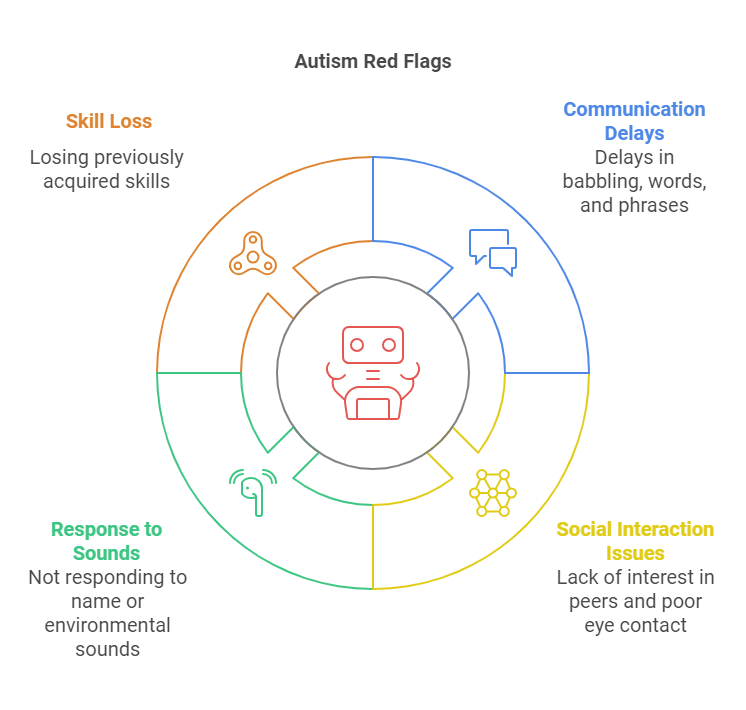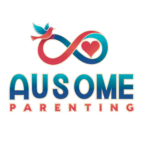no
The CDC reports that 1 in 36 children are diagnosed with autism1. Autism spectrum disorder (ASD) affects interaction, learning, and behavior. Signs often appear early in a child’s development making the importance of early recognition of autism diagnosis and intervention invaluable for every parent worrying for his child’s future2.
Recognizing potential autism in your child can be challenging2. However, early interventions can help children develop skills and overcome challenges1. This can lead to improved long-term outcomes.

This guide explores the autism diagnostic process. It covers recognizing early signs, seeking professional help, and understanding the diagnosis steps. The process involves a thorough evaluation by specialists.
Evaluations include parent interviews, record reviews, and skill assessments. Specialists also observe the child during play2. Neurologists, psychiatrists, and pediatric psychologists with autism expertise may be involved1.
After evaluation, specialists interpret results to create a personalized treatment plan. The plan focuses on communication, social skills, and behavior2. It’s tailored to each family’s needs and can be adjusted.
Support and resources are provided throughout the process2. Learning about autism screening tests and early signs can help you navigate this journey. This knowledge empowers you to advocate for your child’s needs.
Key Takeaways
- Autism affects 1 in 36 children, with signs typically appearing early in development.
- Early recognition of autism signs and seeking professional help are crucial steps for parents.
- The autism diagnostic process involves a comprehensive evaluation by trained specialists.
- Personalized treatment plans focus on communication, social skills, and behavior.
- Support and resources are available for families throughout the diagnostic and treatment process.
Understanding the Early Signs toward Autism diagnosis
For a comprehensive understanding of these early signs and red flags, I highly recommend referring to my book, “Ausome Parenting: The Guide to Endless Love, Emotional Support and Accept for Your Autistic Child.” In this book, I provide an extensive list of early signs, complete with vivid, real-life examples. These detailed descriptions can help parents recognize potential indicators of autism in their child’s behavior, even subtle ones that might otherwise go unnoticed.
The examples in the book range from communication delays and unusual play patterns to specific sensory sensitivities and repetitive behaviors. By presenting these signs in context, with relatable scenarios, parents can more easily connect the information to their own experiences with their child.
Remember, while being aware of these signs is crucial, it’s equally important to consult with healthcare professionals for a proper diagnosis. The examples in my book are meant to guide and inform, not to replace professional medical advice.
Parents should know the early signs of autism in children. These signs usually appear in the first 1-2 years of life3. They can include social challenges, repetitive behaviors, and sensory sensitivities.
The number of signs may vary among children. They might change or become more noticeable as kids grow older3.
Social Communication Challenges
Watch your child’s social interaction and communication development3. Kids with autism may not use eye contact or respond to their name.
They might struggle to point, use gestures, or copy others’ actions3. Understanding simple instructions by age 1-2 can also be difficult3.
These issues can make it hard to engage in conversations or share emotions with others.
Repetitive Behaviors and Interests
Children with autism often show repetitive behaviors and intense interests3. They may prefer routines and get upset by changes3.
Repeating body movements is common. This includes arching backs, flapping hands, or walking on toes3.
These behaviors provide comfort but can interfere with daily life and social interactions.
Unusual Sensory Sensitivities
Sensory sensitivities are another sign to watch for in children3. Some kids may be overly sensitive to certain stimuli.
Others might seek out specific sensations3. Strong preferences for textures, colors, or sensory experiences are common3.
These sensitivities can affect behavior and make everyday situations challenging.
If you spot these signs, seek further evaluation. Early screening tools like M-CHAT can help identify kids needing assessment4.
Trust your instincts and get support. Early intervention programs are key to improving outcomes for children with autism4.
When to Seek Professional Help for autism diagnosis
Parents should watch their child’s growth closely. Every child develops differently, but certain milestones show typical progress. The AAP suggests checking a child’s development at 9, 18, and 30 months. These checks include autism screening.
Your pediatrician can help if you’re worried. Autism can be spotted in children as young as 18 months old. By age 2, a professional can make a reliable autism diagnosis.
Trust Your Instincts as a Parent
Speak up if you’re concerned about your child’s growth. Your parental instincts are crucial for spotting issues early. Health experts can detect autism in 18-month-old children.
By age 2, a qualified professional can make a reliable autism diagnosis. Early detection and treatment lead to better outcomes for children with autism.
Developmental Milestones and Red Flags
Knowing key milestones helps you see when your child might need extra help. The AAP recommends autism screening at 18 and 24 months. This ensures early identification and treatment.
Some red flags for autism include:
- Not smiling at others by six months
- Not gesturing or pointing to communicate by 12 months
- Not babbling by 12 months
- Not using single words by 16 months
- Not using two-word phrases by 24 months
- Not responding to sounds or their name by three years
- Poor eye contact
- Little interest in other children
- Losing skills they once had

Talk to your child’s doctor if you notice these signs. They can guide you through screening and evaluation. Tools like M-CHAT-R/F for toddlers or SCQ for older kids may be used.
Remember, early identification and intervention can make a significant difference in your child’s development and long-term outcomes. Trust your instincts, stay informed about developmental milestones, and don’t hesitate to seek professional guidance when needed.
The Role of Pediatricians in Autism Screening
Pediatricians are key in spotting autism spectrum disorder (ASD) early. They do this through regular check-ups. The American Academy of Pediatrics suggests ASD screenings at 18 and 24 months7. ASD can often be found as early as 18 months.
During check-ups, doctors use tools like the M-CHAT to check for autism risk. This tool helps find possible ASD signs in kids 16 to 30 months old. Parents answer questions about their child’s behavior and growth.
Doctors also use their expert knowledge to spot any ASD red flags. They may ask about milestones like pointing or pretend play. They watch how kids communicate and behave.
If a screening shows concerns, the doctor will suggest a full evaluation7. A team of specialists usually does this evaluation. The team may include a developmental pediatrician, psychologist, and speech therapist7.
In 2020, 1 in 44 eight-year-olds in the U.S. had ASD8. But diagnosis rates differ among racial groups. African American kids often get diagnosed later than others8. Latino and white families face barriers in getting help8.
To fix these issues, new programs are being created. ECHO Autism trains doctors to spot ASD signs. The STAT tool helps screen two-year-olds for autism8. These efforts aim to improve early ASD detection.
As a parent, attend all check-ups with your pediatrician. Share any worries about your child’s growth. Your input is crucial in helping your doctor make the best choices for your child.
Preparing for the Autism Evaluation
Getting ready for your child’s autism evaluation can be overwhelming. Gathering information and knowing what to expect can ease your worries. Autism spectrum disorder (ASD) affects each child differently9.
Gathering Relevant Medical and Developmental Information
Compile your child’s medical history before the evaluation. Include birth records, developmental milestones, and previous evaluations or diagnoses. This info helps the assessment team understand your child’s unique needs.
Misdiagnosis is common in autism evaluations. Children are sometimes wrongly identified with other disorders like ADHD9. Australian guidelines suggest autism diagnosis should include a comprehensive needs assessment and medical evaluation10.
What to Expect During the Assessment Process
The autism evaluation involves a thorough review of your child’s behavior and development. Various diagnostic tools and criteria may be used, including the DSM-5-TR and other specific tools10.
Common screening tools include the M-CHAT-R/F and STAT11. The evaluation team typically includes developmental pediatricians, child psychologists, and neurologists experienced in diagnosing autism9.
They may use tests like ADOS-2, CARS-2, and GARS-311. Cognitive testing is crucial to understand your child’s thinking abilities for educational planning9.
The process may also evaluate social skills and repetitive behaviors. Tools like ADOS and CSBS, a play-based instrument for young children, might be used9.
Waiting lists for autism assessment are common, especially for public services. Private assessments can be expensive but may have shorter wait times. Medicare rebates can help with some costs10.
Early intervention is crucial for supporting autistic children’s development and well-being10. Being prepared can help you support your child through the evaluation and beyond.
Autism Diagnosis Steps
The autism diagnostic journey can feel daunting for parents. Understanding the process can help you feel more prepared. A team of experts will conduct a thorough evaluation to assess your child.
Comprehensive Diagnostic Evaluation
The evaluation gathers information from various sources to understand your child’s development. It includes a detailed parent interview about your child’s history and current challenges. You’ll need to provide medical records and previous assessments.
The team may also assess your child’s cognitive abilities and language skills. They’ll use standardized tests and observations to evaluate adaptive functioning12.
Involvement of a Multidisciplinary Team
A team of professionals from different fields works together to evaluate your child. This may include a developmental pediatrician, child psychologist, and speech-language pathologist. An occupational therapist and other specialists might join if needed.
Each expert assesses different aspects of your child’s development. This ensures a well-rounded approach to diagnosis12.
Diagnostic Tools and Criteria
The team uses standardized tools to assess your child’s behaviors. Two common tools are the Autism Diagnostic Observation Schedule (ADOS) and Autism Diagnostic Interview-Revised (ADI-R). ADOS involves structured play to observe autism-related behaviors.
ADI-R is a detailed parent interview about your child’s development. The Diagnostic and Statistical Manual (DSM-5) outlines the criteria for autism diagnosis12.
For an autism diagnosis, your child must show social communication deficits. They must also have restricted, repetitive behaviors or interests. These symptoms should appear early and affect daily life12.
Remember, every child with autism is unique, and the diagnostic process is tailored to your child’s individual needs and challenges.
The CDC recommends screening all children for autism three times by age three. These screenings happen at 9, 18, and 24 or 30 months. A formal diagnosis may require more evaluations13.
Children with ASD may have other medical issues. These can include stomach problems, epilepsy, sleep troubles, and sensory sensitivities. These may need further evaluation and treatment1312.
| Diagnostic Tool | Purpose |
|---|---|
| Autism Diagnostic Observation Schedule (ADOS) | Structured play sessions and activities to observe behaviors associated with autism |
| Autism Diagnostic Interview-Revised (ADI-R) | Comprehensive parent interview exploring developmental history and current functioning |
| Diagnostic and Statistical Manual of Mental Disorders, Fifth Edition (DSM-5) | Outlines the diagnostic criteria for autism spectrum disorder |
Early intervention is crucial for your child’s development. Work closely with the assessment team to get the right support. This will help your child reach their full potential12.
Understanding the Autism Spectrum
Autism is a complex brain disorder that affects people differently. It includes a wide range of abilities and challenges. Parents need to understand their child’s unique traits.

Levels of Support and Severity
The DSM-5 outlines three support levels for autism spectrum disorder. These levels are based on symptom severity and daily functioning impact.
Professionals use the DSM-5 to diagnose autism. They assess signs through observations, interviews, and reports. The three levels of autism support are:
| Level | Description |
|---|---|
| Level 1 | Children need support |
| Level 2 | Children need substantial support |
| Level 3 | Children need very substantial support |
Support levels shouldn’t determine service eligibility. A child’s support needs may change over time14.
Co-occurring Conditions and Challenges
Autism can occur with other conditions like ADHD or intellectual disability. These can create extra challenges and need special support14.
Sensory sensitivities vary widely from person to person. They contribute to each person’s unique autism profile15.
As a parent, understanding your child’s specific needs and challenges is crucial for providing the best possible support and advocating for their well-being.
Professionals use DSM-5 criteria for diagnosis. They look at social skills, repetitive behaviors, and sensory issues15.
The diagnosis process involves many experts. They use tools like ADOS, ADI-R, and other assessments1615.
Understanding autism helps you support your child better. You can find the right help for their unique needs. This knowledge empowers you to help your child thrive.
Emotional Impact of an Autism Diagnosis
An autism diagnosis for your child can stir up many emotions. It’s normal to feel overwhelmed, confused, and sad. Autism affects social skills, communication, and behaviors in people with ASD17.
Processing these feelings is key to supporting your child. It’s also important for your own well-being.
Processing Complex Emotions
Parents often feel a mix of emotions after an autism diagnosis. These can include relief, anger, shock, grief, and hope17. It’s okay to feel this way.
Give yourself time to work through these feelings. Remember, they’re all valid and normal.
Professional help can offer a safe space to express yourself. A neurodivergent therapist can provide specialized support for autism-related concerns17.
Seeking Support and Resources
Building a strong support network is crucial. Connect with other parents who understand your journey. Join autism support groups to share experiences and learn from others.
Educate yourself about autism through articles, books, and videos17. This knowledge will help you make informed decisions about your child’s care.
Work with healthcare pros to create a tailored treatment plan. This can include pediatricians, occupational therapists, and speech therapists.
Take care of your own mental health too. Try exercise, mindfulness, or hobbies to manage stress. Seek therapy or support groups for parents of autistic children.
Embracing your child’s unique strengths and celebrating their achievements, no matter how small, can bring joy and perspective to your journey as a parent of a child with autism.
Early Intervention and Treatment Options
Early intervention is vital after an autism diagnosis. It can greatly improve outcomes for children with autism. Work with your child’s healthcare team to create a personalized treatment plan.
Evidence-based interventions form the core of effective autism treatment. Applied Behavior Analysis (ABA) therapy can enhance life skills, intellectual abilities, and social skills. The Early Start Denver Model (ESDM) improves language and communication in young children.
Speech therapy boosts verbal and nonverbal communication skills. It helps with describing feelings, identifying items, and using hand signals. Occupational therapy develops everyday skills like feeding and dressing.
Early intervention is not a sprint, but a marathon. Celebrate every milestone, no matter how small, and remember that progress is progress.
Physical therapy enhances motor skills, posture, and coordination. Nutritional therapy addresses digestive issues and picky eating habits. Cognitive-behavior therapy (CBT) helps manage emotions and cope with social situations.
Consistency at home can speed up your child’s progress in therapy. Keep detailed records of your child’s achievements and challenges. Stay in touch with therapists to ensure a team approach to care.
| Therapy | Benefits |
|---|---|
| ABA Therapy (DTT, PRT) | Improves life skills, intellectual abilities, and social skills |
| Speech Therapy | Enhances verbal and nonverbal communication skills |
| Occupational Therapy | Develops everyday skills and teaches use of assistive devices |
| Physical Therapy | Improves motor skills, posture, coordination, balance, and muscle control |
| Cognitive-Behavior Therapy (CBT) | Helps manage emotions and cope with social situations |
Every child with autism is unique. What works for one may not work for another. Be patient and stay informed. Advocate for your child’s needs to ensure they get the best care181920.
Building a Support Network
An autism diagnosis can bring mixed emotions. Building a strong support network is key for parents of autistic children. Connecting with others can offer emotional support, advice, and community.

Joining Autism Support Groups
Parent support groups are great for building your autism support network21. These groups offer a safe space to connect with others who understand your journey. They provide emotional support and practical advice for navigating life after diagnosis22.
Consider both local and online support groups. Local groups host meetings and events for face-to-face connections. Online communities let you connect with parents worldwide, sharing experiences and resources anytime.
Connecting with Other Parents
Reach out to other parents of autistic children in your community. Every area has different resources for families21. Local parents can offer valuable insights and recommendations specific to your region.
Chat with parents at therapy appointments, school events, or community gatherings. Sharing experiences can create a sense of camaraderie. Together, you can celebrate your children’s unique strengths and milestones.
Building a strong support network takes time but offers immense benefits. Surrounding yourself with understanding individuals helps you cope with stress. This is crucial for parents caring for autistic children21.
Prioritize self-care and seek support to maintain your well-being. This helps you provide the best care for your child22. Remember, you’re not alone on this journey.
Collaborating with Healthcare Professionals and Educators
Parents of children with autism must work closely with healthcare professionals and educators. This ensures the best care and support for their child. Healthcare coordination is vital for addressing challenges faced by families dealing with autism.
Care coordination is crucial for individuals with ASD who need services from multiple providers. It ensures seamless and efficient care delivery across different systems23.
A central point of contact in healthcare coordination empowers families and provides necessary support24. Nursing professionals often play a central role in care coordination for individuals with ASD. They collaborate with other healthcare providers, therapists, educators, and community resources23.
Developing a Comprehensive Treatment Plan
Working with a healthcare team helps develop a comprehensive treatment plan for a child’s unique needs24. This plan includes specialized ASD services like Applied Behavior Analysis, speech therapy, and occupational therapy.
Social skills training and parent education are also important components23. Using technology enhances communication among healthcare providers, caregivers, and the child. This leads to more comprehensive, timely, and individualized interventions24.
Advocating for Your Child’s Needs
Advocating for a child’s rights and needs is crucial as they enter the educational system. Participating in developing an Individualized Education Plan (IEP) outlines necessary accommodations and services for school success.
Improving provider coordination involves effective communication through electronic health records and regular meetings. Developing comprehensive care plans and involving families in decision-making is also essential23.
Challenges in autism care include accessing services in rural areas and healthcare costs24. Accessibility remains a significant challenge, especially for low-income families and minority communities. This impacts timely access to essential services like early screening and interventions23.
Advocating for comprehensive insurance coverage and increased autism awareness can reduce financial barriers. This ensures accessible care for all individuals with autism, particularly among groups with lower socioeconomic status24.
Celebrating Your Child’s Unique Strengths
Parents of children with autism should focus on a strengths-based approach. This celebrates neurodiversity and embraces their child’s unique abilities25. An autism diagnosis reveals opportunities to nurture distinct talents26.
Many autistic individuals have enhanced sensory perception and exceptional memory skills. They excel at tasks requiring precision and accuracy26. These strengths can lead to success in art, design, and technology fields26.
“When you take a strengths-based approach to autism, you start to see the world in a whole new light. You begin to appreciate the incredible talents and abilities that your child possesses, and you learn to celebrate their achievements, no matter how small they may seem.”
Value your child’s unique perspective to create a supportive environment. Celebrate each milestone, recognizing that progress varies in pace and approach25. Use visual supports and assistive technology to nurture understanding and connection25.
Prioritize self-care to maintain your physical and emotional resilience. Build a strong support network with other parents of autistic children25. This can provide encouragement and valuable resources.
Embrace neurodiversity and focus on your child’s strengths. This helps develop a positive self-image and unlocks their full potential25. Celebrate your child’s unique gifts and advocate for needed support and accommodations.
Conclusion
The autism journey is unique for every parent and child. It’s an ongoing learning experience filled with challenges and triumphs. Recognizing early signs and seeking professional help are crucial steps in this process27.
Autism symptoms vary widely from person to person. Early diagnosis is key to accessing appropriate therapies and support services27. A thorough assessment by a team of experts will reveal your child’s strengths and challenges2827.
Trust your instincts and be your child’s advocate. Work with healthcare professionals to create a comprehensive treatment plan. This may include ABA therapy, speech therapy, and special education services28.
Build a strong support network. Connect with local autism groups and other parents who understand your experiences. Their guidance and emotional support can be invaluable.
Celebrate your child’s unique strengths and accomplishments. Create a positive environment that allows your child to thrive. With love and support, you can make a significant difference in your child’s life.
FAQ
What are some early signs of autism that I should look out for in my child?
Early signs of autism include difficulty with conversations and reduced sharing of emotions. Watch for repetitive movements, rigid routines, and unusual sensory reactions. Look for delays in smiling, gesturing, and language development.
Other red flags are poor eye contact and little interest in other children. Be aware of any loss of previously acquired skills. If you notice these signs, consult your pediatrician promptly.
What should I do if I suspect my child may have autism?
Trust your parental instincts and discuss your concerns with your child’s pediatrician. They can perform developmental screening tests to assess autism risk. If autism is suspected, your pediatrician will refer you to specialists for a thorough evaluation.
How can I prepare for my child’s autism evaluation?
Gather relevant medical and developmental information, including birth history and milestones. Be ready for a comprehensive review of your child’s behavior and development. Expect cognitive and language assessments, as well as autism-specific evaluations by a team of specialists.
What are the steps involved in an autism diagnosis?
The autism diagnosis process involves a thorough evaluation by a team of specialists. It includes a parent interview, review of records, and observation of the child during play. Diagnostic tools like ADOS and ADI-R are used to assess behavior and determine autism criteria.
What is the autism spectrum, and how does it affect individuals?
Autism is a spectrum disorder with varying abilities, challenges, and support needs. The DSM-5 outlines three support levels based on symptom severity and impact on daily functioning. Autism can co-occur with other conditions, requiring specialized support.
What emotions might I experience after my child receives an autism diagnosis?
Receiving an autism diagnosis for your child can stir up complex emotions. You might feel confused, sad, or even relieved. It’s important to process these feelings and seek support.
Reach out to friends, family, and autism support groups for guidance and understanding. These resources can provide a safe space to share your experiences.
What are some early intervention and treatment options for children with autism?
Early intervention is crucial for improving outcomes in children with autism. Evidence-based therapies like ABA, speech, and occupational therapy can enhance communication and social skills. Work with your child’s healthcare team to create a personalized treatment plan.
How can I build a support network as a parent of a child with autism?
Building a strong support network is vital for parents of children with autism. Join autism-specific support groups, both in-person and online, for valuable information and resources. Connect with other parents to share experiences, strategies, and celebrate achievements together.
How can I collaborate with healthcare professionals and educators to support my child with autism?
Work closely with your child’s medical team to develop a comprehensive treatment plan. Advocate for your child’s educational needs by participating in their Individualized Education Plan (IEP) development. Ensure the IEP outlines necessary accommodations and services for your child’s success in school.
How can I celebrate my child’s unique strengths and abilities?
Embrace your child’s differences and focus on their abilities rather than limitations. Encourage their interests, passions, and skills, celebrating all achievements, big and small. Create a supportive environment that values your child’s individuality to foster positive self-image and growth.
Source Links
- https://www.bannerhealth.com/healthcareblog/teach-me/understanding-your-childs-autism-evaluation-process – Understanding Your Child’s Autism Evaluation Process| Banner
- https://learnbehavioral.com/blog/the-autism-diagnosis-process-what-to-expect – The Autism Diagnosis Process: What to Expect – LEARN Behavioral
- https://raisingchildren.net.au/autism/learning-about-autism/assessment-diagnosis/early-signs-of-asd – Early signs of autism: young children
- https://chicagoabatherapy.com/resources/articles/diagnose-autism-children/ – How to Diagnose Autism in Children: A Comprehensive Guide by Chicago ABA Therapy | Chicago ABA Therapy
- https://www.healthline.com/health/autism/autism-screening – Your Guide to Autism Screening
- https://www.autismempowerment.org/understanding-autism/getting-diagnosis/ – Getting an Autism Spectrum Diagnosis
- https://www.cdc.gov/autism/diagnosis/index.html – Screening for Autism Spectrum Disorder
- https://www.ncbi.nlm.nih.gov/pmc/articles/PMC11036916/ – Diagnostic Evaluation of Autism Spectrum Disorder in Pediatric Primary Care
- https://childmind.org/article/what-should-evaluation-autism-look-like/ – What Should an Evaluation for Autism Look Like? – Child Mind Institute
- https://raisingchildren.net.au/autism/learning-about-autism/assessment-diagnosis/autism-diagnosis – Autism diagnosis for children: a guide
- https://www.empowerbh.com/blog/how-to-prepare-for-an-autism-evaluation/ – Understanding How to Prepare for an Autism Evaluation
- https://www.healthychildren.org/English/health-issues/conditions/Autism/Pages/Diagnosing-Autism.aspx – How Is Autism Diagnosed?
- https://autismakron.org/diagnosis/ – Diagnosis – Autism Society Greater Akron
- https://raisingchildren.net.au/autism/learning-about-autism/assessment-diagnosis/dsm-5-autism-diagnosis – DSM-5-TR: autism diagnosis
- https://www.adinaaba.com/post/a-comprehensive-guide-to-autism-spectrum-disorder – What Is Autism?: Understanding Signs, Diagnosis, Treatment, and Life with Autism Spectrum Disorder
- https://www.rainbowtherapy.org/blogs-understanding-the-assessment-method-for-autism/ – Autism Assessment Methods Explained – Rainbow Therapy
- https://sachscenter.com/what-to-expect-after-an-autism-diagnosis/ – What to Expect After An Autism Diagnosis: A Guide for the Newly Diagnosed – Sachs Center | ADHD & Autism Testing and Treatment
- https://www.helpguide.org/mental-health/autism/autism-treatments-therapies-interventions – Autism Treatments, Interventions, and Therapy Options
- https://www.cdc.gov/autism/treatment/index.html – Treatment and Intervention for Autism Spectrum Disorder
- https://lizardcentre.com/navigating-the-first-steps-of-autism-treatment/ – Navigating the First Steps of Autism Treatment: A Guide for Parents and Caregivers
- https://www.behaviorplace.com/blog/firststeps – First Steps After an Autism Diagnosis: A Parent’s Guide
- https://www.rainbowtherapy.org/blogs-first-steps-after-receiving-an-autism-diagnosis-a-guide-for-parents/ – Steps After an Autism Diagnosis: Parent Guide
- https://www.rainbowtherapy.org/care-coordination-of-autism/ – Autism Care Coordination: Challenges and Strategies
- https://www.goldstarrehab.com/parent-resources/healthcare-coordination-for-autism – Effective Strategies For Healthcare Coordination
- https://www.thebehaviorplace.com/single-post/unconditional-love-navigating-the-journey-of-parenting-a-child-with-autism-spectrum-disorder – Unconditional Love: Navigating the Journey of Parenting a Child with Autism Spectrum Disorder
- https://www.abtaba.com/blog/strengths-in-autism – Strengths and Abilities In Autism
- https://www.abtaba.com/blog/diagnosis-of-autism – Screening and Diagnosis of Autism Spectrum Disorder
- https://cultivatebhe.com/asd-evaluation/ – Understanding the Autism Spectrum Disorder | Cultivate BHE


